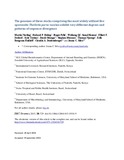The genomes of three stocks comprising the most widely utilized live sporozoite Theileria parva vaccine exhibit very different degrees and patterns of sequence divergence.

View/
Date
2015-09Author
Norling, M
Bishop, RP
Pelle, R
Qi, W
Henson, S
Drábek, EF
Tretina, K
Odongo, D
[et al.]
Language
enMetadata
Show full item recordAbstract
There are no commercially available vaccines against human protozoan parasitic diseases, despite the success of vaccination-induced long-term protection against infectious diseases. East Coast fever, caused by the protist Theileria parva, kills one million cattle each year in sub-Saharan Africa, and contributes significantly to hunger and poverty in the region. A highly effective, live, multi-isolate vaccine against T. parva exists, but its component isolates have not been characterized. Here we sequence and compare the three component T. parva stocks within this vaccine, the Muguga Cocktail, namely Muguga, Kiambu5 and Serengeti-transformed, aiming to identify genomic features that contribute to vaccine efficacy.
Results
We find that Serengeti-transformed, originally isolated from the wildlife carrier, the African Cape buffalo, is remarkably and unexpectedly similar to the Muguga isolate. The 420 detectable non-synonymous SNPs were distributed among only 53 genes, primarily subtelomeric antigens and antigenic families. The Kiambu5 isolate is considerably more divergent, with close to 40,000 SNPs relative to Muguga, including >8,500 non-synonymous mutations distributed among >1,700 (42.5 %) of the predicted genes. These genetic markers of the component stocks can be used to characterize the composition of new batches of the Muguga Cocktail.
Conclusions
Differences among these three isolates, while extensive, represent only a small proportion of the genetic variation in the entire species. Given the efficacy of the Muguga Cocktail in inducing long-lasting protection against infections in the field, our results suggest that whole-organism vaccines against parasitic diseases can be highly efficacious despite considerable genome-wide differences relative to the isolates against which they protect.
Keywords: Theileria parva ; East coast fever; Live vaccine; Muguga Cocktail; Protozoan parasite; Genome sequence; Single nucleotide polymorphisms; Comparative genomics; Vaccinology
